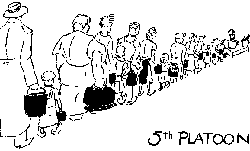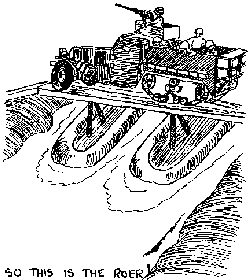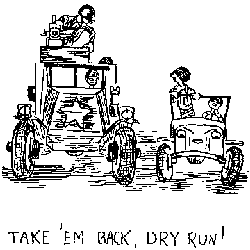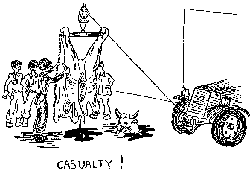| History - 49th A.I.B. - Company 'B' |
 | Index
|
| Index
| | Next |
| Next |
|
(Pages 17-20)

22 February
An FO moved in with the first platoon, and started to direct fire on the Kraut positions across the river. The Krauts evidently located the OP, for the first platoon experienced frequent and fairly accurate shelling for the rest of the time. At dusk, Minton came up with his track, and drew a barrage of fire from mortars. One of these shells was a direct hit on the CP, which destroyed the OP. S/Sgt Hensley found that a piece of shrapnel from this round had chewed into his notebook which he was carrying in his hip pocket. It was during this barrage that we received our first Holland casualty, Pfc. Anton Heintz, 'Polkys' best friend. The second squad, exposed on the left flank, received a lot of fire, both artillery and small arms, and Pfc. Albert Kiselica cut his hand diving for cover, and had to be evacuated along with Heintz.
The second platoon, too, was troubled with shelling during the day, but found that many of the shells contained high explosive propaganda which made good reading, if nothing else. At about 2200, Chester Hobbs, standing guard, spotted a small enemy patrol, and blasted away at them with such vigor with his carbine that the men on the machine gun thought it was another machine gun, and opened fire as well, and for awhile a real battle seemed to be in progress.
The patrol escaped.
The third platoon, though in reserve, had a little excitement when a hand grenade was thrown at one of their mortar positions at about 2200. The grenade was about thirty yards
|
wide of its mark, though, and caused no casualties. Although a patrol was sent out to investigate, nothing was found. Reports were received in Posterholt of enemy patrols in the town, and patrols led by Lt. Kenneally and Lt. Bell were sent out to investigate, but failed to encounter anything.
At 0245 the preliminary barrage for the jump-off across the Roer started, and lasted 45 minutes. The Krauts replied by heavily shelling our positions, cutting communication lines in several places. Jameson and Sena, while repairing these lines were caught in a barrage, and Sena was slightly wounded by a rock torn up by these explosions, which struck him in the ankle. Telephone maintenance was discontinued for the time being.
Tanks came up to join the first platoon at Paarlo, and light shelling was experienced throughout the day with small arms fire on the second squad positions.
The second platoon experienced heavier artillery during the day, and Lt. Meech, believing that the enemy OP might have been located in a haystack about 500 yards southeast of Holtz, directed fire by

|
-- 17 --
|
the TDs that were attached to the second platoon on this position. Taking a squad of men, mounted on the back of one of the TDs, he went out to reconnoiter. No enemy were found around the haystack, but one of our tanks, mistaking the TD for an enemy tank, opened fire on them, and the boys had a few bad moments before the mistake was cleared up.
24 February
Lt. Rankin led patrol from the first platoon to reconnoiter the town of Voorsel, and was able to determine that about two squads of Krauts were occupying that position. They were sighted, however, and a brief exchange of fire was made, but all returned safely. The shelling of the first platoon positions was heavier than ever during the day, and it was during this barrage that we lost Pfc. Stuart Poulson, the first man in the company to be killed In combat. Another patrol was sent out that night to gain information, but nothing was gained. During the night, the second platoon sent out a patrol led by Lt. Meech to reconnoiter Trieste, but could find out nothing about the strength in that position, except that it seemed to be lightly held.

|

25 February
The third platoon sent up two squads to relieve the first platoon at Paarlo, while the first platoon moved out to attack Voorsel. The second platoon moved out from Holst and set up a base of fire, and at dawn the first platoon, supported by a platoon of tanks from C Co. of the 36th attacked Voorsel. They were surprised, and pleased to find that the Germans had abandoned the position, and no resistance was encountered from the group of frightened civilians left in the positions. The Krauts had plenty of time before they left the area to sow mines and booby traps in large numbers. Lt. Rankin was injured by a Shu mine, but continued to direct the consolidation of the positions; he later returned to the company. Pfc's Beck and Ray Sena (his second of the war) were wounded at this time.
While Voorsel was being consolidated the second platoon moved out to take Trieste, while the first platoon set up a base of fire. The second platoon attacked, and took their objective, without encountering opposition, but again ran into a heavily mined and booby trapped area, from which quite a few casualties resulted. It was during this operation that Pfc. Hans Bergmayr was killed, and Pvts. Jack McDade and Leo Mallet were wounded. Artillery fire began coming in on the second platoons positions,
|
-- 18 --
|

while they were organizing, and S/Sgt. Leroy Davis and Pfc. Frank Sposito were injured by this fire, but later returned to the company.
We had had our baptism of fire and had not emerged unscathed. The first and second platoons settled down to hold their positions while in Paarlo, and the 88th Recon moved into Holst.
26/27 February
The third platoon spent the day moving back and forth between Holst and Paarlo, while the first and second platoons, although receiving some artillery fire, spent a fairly peaceful time and sent a few squads back at a time for showers, hot chow, and a little much needed rest. We were a blurry-eyed, unshaven lot by this time, but we were combat soldiers, and we took a little pride in this at least. The fourth platoon during this time had been outposting an area for battalion. Though they suffered a few scares, especially from the artillery going off at unpredicted times, around their positions, practically caving in a few ear drums, they met with little trouble. This phase is referred to by the fourth platoon veterans as the 'Fourth platoon's phony war.' It was during these two days that S/Sgt Thomas Schwartz was evacuated suffering from concussion.
At 2200 we were relieved by a Cavalry Recon. outfit and we concentrated in
|
Posterholt, preparing to move out again.
28 February
At 004S we left Posterholt, crossing the Roer River into Germany, and halting at Hllsfarth. Here we stayed for about an hour and a half, preparing for the attack of Arsbeck, Germany. After this break the company moved out in battle formation, mounted in the vehicles. We were very nervous at this time, and everybody looked anxiously in the sky for Messerschmidts, or scanned the woods for snipers, as we passed by. The third platoon led in the attack, supported by a platoon of tanks. and a squad of engineers, and at approximately 1500 the town fell without opposition, and after reconnoitering the surrounding territory we decided to remain there for the night, resting up from the long trip and action we had just finished.
1 March
The company rose early to continue action against the enemy. However, the march was called off, so we spent the day cleaning up ourselves and our weapons. Patrols continued to investigate the surrounding pillboxes and houses, and several prisoners resulted. The Investigating was done by the fourth platoon. Teddy Waigenfeld, our German speaking Philadelphian, helping a great deal in the persuasion, of the Krauts.

|
-- 19 --
|

2 March
As we moved out about noon, we were part of CCB, which was in reserve, and therefore did not expect much action immediately. The weather, which had been warm, dropped well below freezing, and we spent a cold night sleeping in the tracks about 3 miles north of Locht, Germany.
3/4 March
We pulled into Eyll, Germany, where we spent two days. About five hundred cases of eggs were discovered in a warehouse and captured, the diet being enriched by these as well as by a good sized beef, which had fallen casualty in Arsbeck. During our stay here some of the gaps in our strength were filled up by the return to the company of Sena, Syes, Boisvert, and Hall, along with six new replacements. Gaps in the T/P were filled by the promotion of Cpl. Jacobs to S/5gt., Pfcs. Streeter and P. T. Peterson to Sgt., T/5 Ryder to T/4. and Pfc Minton to T/5.
5 March
At 0430 we left Eyll, Germany. The objective was to reach and hold the west bank of the Rhine, and if possible, to reach the east bonk, and take the town of Wesel. The Krauts, realizing that this was the last escape gap for their men trapped in the pocket west of the Rhine, had reinforced
|
this area, throwing in elements from five or more divisions, and were determined to hold it at all cost. We had no inkling of this until at about 0900, coming to the little town of Lintfort, we ran suddenly into fanatical opposition. The third platoon, in the lead, moved through the town mounted, engaging several of the enemy in the town square with fire from their vehicular weapons, and continuing through the town, leaving the mopping up operations to the supporting platoons.
Then, without warning, a German anti-tank gun, firing from the left flank, caught S/Sgt Don Drake's lead track, disabling it. Men were seen running to their positions, and it was obvious that we had been seen. However, they had the advantage of prepared positions, and the men, forced by the anti-tank fire to dismount, found themselves exposed to fire from small arms and automatic weapons almost immediately. They sought what cover the shallow ditches to the side of the rood offered, and returned the fire, while Pfc. Matt White and Pvt. Joe Irvine manned their heavy thirties from their half-tracks, and managed to keep the anti-tank gunners down to an extent that they could not fire again on the half-tracks. The only real cover in the area was a large brick house, about fifty yards from the rood on the right. The platoon began to inch their way slowly and painfully towards this house, while returning the withering fire which

|
-- 20 --
|